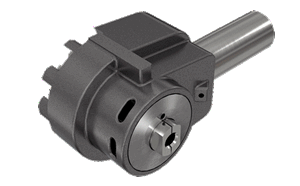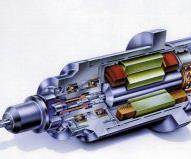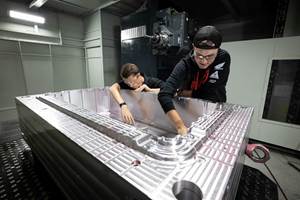VIDEO: 6 Factors a Mold Builder Should Consider in a CNC Control
Many mold builders choose high-speed cutting over EDM because CNCs are able to meet the required tolerances and finishes. The control is key to this. Here we break down what a mold builder should look for in a CNC control.
There are six key factors that mold builders should consider when choosing a new CNC control. Here Heidenhain's Director of Business Development, Machine Tools Gisbert Ledvon breaks them down one-by-one.
Transcript
Gisbert Ledvon:
- Spatial plane. This is a nice feature if you want to do five-sided machining. It allows the operator to just use one simple program, and then use the spatial plane function to move around the five sides of the mold. You can basically use the same program and machine your part on five sides.
- Contour mitigation feature. This feature allows you to optimize your speeds and feeds without being at the machine. You're allowing the machine tool to run the toolpath within a precise tolerance band, like a racetrack. If you want to go very close to a corner to speed up as quickly as you can, you can use this function and the machine will automatically adjust the speeds, read ahead to what points are coming in the program and optimize the behavior in the motion around the corners to maximize the speed in this application.
- Linear encoder capabilities. Ensure that your controller is able to interface with linear encoders because linear encoders on all axes guarantees maximum positioning accuracy. You don't rely only on a rotary encoder, which is mounted on the ball screws, you want to know exactly where your machine is at any given time. That's why we use linear encoder technology. If the controller is not capable of doing it, you will have a very difficult time making high-precision parts, specifically if you have a longer travel or if you have a larger machine tool. You will precisely position the machine using linear encoder technology.
- Vibration mitigation. This feature is nice specifically for moldmakers, as they like to get as much material removed as quickly as possible. The downside is that sometimes you overload the spindle or cutting tool, which can create harmonics in the machine. The machine starts to vibrate, which can be reflected in your workpiece or even break the tool. With this new control feature, your control can sensor this vibration and slow down the machine to take these harmonics out of the machine tool itself. You don't create any type of vibration on the cutting tool or damage the surface finish because you're overloading the spindle or creating these vibrations.
- Operator flexibility. You want to allow the operator to have flexibility on the machine tool without relying on the CAD/CAM program to bring the program in and the operator just pushes a button. Using touchscreen technology the operator can look into a specific detail he wants to machine, or maybe there is something missing in the program. When you operate, it is possible to make a quick change right on the console. If there's a hole missing and you have to drill and tap it then you can do that right on the control. You need to have that flexibility; otherwise, you have to go back to the programmer and load the program back into the machine to drill this one hole. The operator can do it right on the fly. The control must allow this flexibility and be intuitive.
- Automatic feed control. This is very important for the moldmaking industry because if a mold builder is working with a larger mold and they have to remove a lot of material, they put it on a bigger machine, rough out the material leaving stuck around certain areas, and then take that machine into a full five-axis high-speed milling machine. The problem with that method is that you never know exactly how much you have stuck in each area. It's very difficult for the programmer to have the right speeds and feeds at any given time. If you have an automatic feed control, the control will be able to look at the spindle load and the engagement of the cutting tool when you're machining that part. The control will automatically adjust the speeds and feeds without operator intervention. If there is a lot of material in a corner, the machine will automatically slow down, protect the tool and spindle. Then when there is not so much material or you're cutting air, the machine will automatically speed up for the maximum speed that is allowed for the application. This approach provides the peace of mind to run the machine very efficiently to get the results and surface finishes moldmakers need to stay competitive.
Related Content
3D Printing Enables Better Coolant Delivery in Milling Operations
Just like 3D printing enabled conformal cooling channels in molds, additive manufacturing is now being used to optimize coolant delivery in cutting tools.
Read MoreHow to Eliminate Chatter
Here are techniques commonly used to combat chatter and guidelines to establish a foundation for optimizing the moldmaking process.
Read MoreDevelopments in High-Speed Machining Technology
There have been many exciting developments in high-speed machining relative to machining centers and controls, tooling and CAD/CAM systems.
Read MoreHybrid Milling/Drilling Machine Reduces Total Mold Machining Time
MSI Mold Builders now squares, plus drills and taps eye-bolt holes on 50% of its tools in a single setup using a five-axis milling/drilling center with a universal spindle.
Read MoreRead Next
Reasons to Use Fiber Lasers for Mold Cleaning
Fiber lasers offer a simplicity, speed, control and portability, minimizing mold cleaning risks.
Read MoreAre You a Moldmaker Considering 3D Printing? Consider the 3D Printing Workshop at NPE2024
Presentations will cover 3D printing for mold tooling, material innovation, product development, bridge production and full-scale, high-volume additive manufacturing.
Read MoreHow to Use Continuing Education to Remain Competitive in Moldmaking
Continued training helps moldmakers make tooling decisions and properly use the latest cutting tool to efficiently machine high-quality molds.
Read More



















